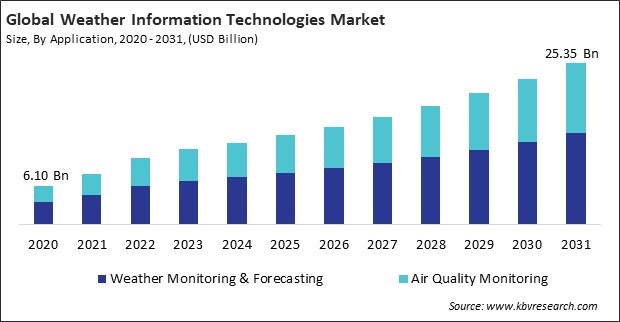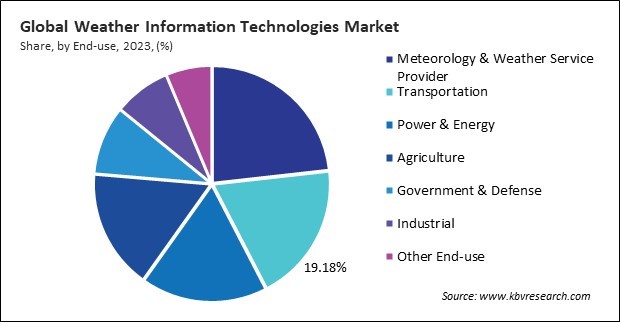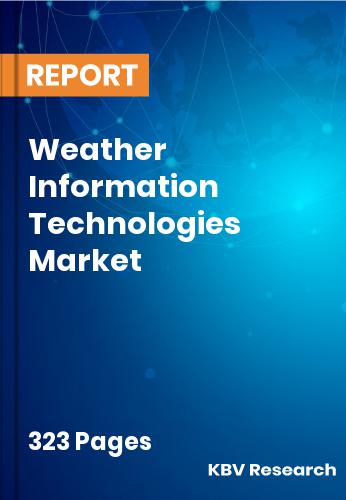“Global Weather Information Technologies Market to reach a market value of USD 25.35 Billion by 2031 growing at a CAGR of 10.2%”
The Global Weather Information Technologies Market size is expected to reach $25.35 billion by 2031, rising at a market growth of 10.2% CAGR during the forecast period.
Accurate weather forecasting is essential for predicting energy generation and demand, enabling utilities to optimize production and distribution, maintain grid stability, and prevent power outages. The need to safeguard energy infrastructure from weather-related disturbances like hurricanes and extreme temperatures, as well as the increased focus on smart grid technologies, are driving the development of weather information systems. Hence, the power and energy segment recorded 17% revenue share in the market in 2023. Furthermore, regulatory pressures and sustainability initiatives encourage energy providers to leverage advanced weather analytics for improved efficiency and risk management.

Global organizations like the World Meteorological Organization (WMO) spearhead international initiatives to enhance early warning capabilities. Their Early Warnings for All initiative aims to ensure that everyone on Earth is covered by life-saving early warning systems by 2027. The program is designed to bridge the gap between data providers and vulnerable communities by improving forecasting, risk communication, and emergency response actions. Additionally, by combining IoT’s ability to collect granular, real-time environmental data with AI’s advanced predictive analytics, modern weather forecasting has evolved into a smarter, more proactive system. This integration allows governments, businesses, and communities to make data-driven decisions, whether optimizing flight routes, improving disaster preparedness, enhancing crop management, or balancing energy grids powered by renewables. Thus, the increased adoption of IoT and AI in weather forecasting is becoming an innovation and a necessity.
However, as the volume and velocity of weather data continue to grow, integrating and managing this information becomes even more complex. Without seamless integration, the value of weather data is diminished, as fragmented or inconsistent information can lead to unreliable forecasts. This complexity is a deterrent, especially for smaller organizations or developing regions lacking the technological infrastructure or expertise to handle such challenges effectively.
Based on component, the market is classified into communication devices, monitoring devices, software, and others. The monitoring devices segment garnered 36% revenue share in the market in 2023. Devices such as automated weather stations, radar systems, barometers, anemometers, and advanced sensors collect vital temperature, humidity, wind speed, and precipitation data. The increasing frequency of extreme weather events and the growing importance of disaster preparedness have intensified the demand for high-precision monitoring equipment.
On the basis of application, the market is bifurcated into air quality monitoring and weather monitoring & forecasting. The air quality monitoring segment recorded 41% revenue share in the market in 2023. Governments and regulatory bodies enforce stricter emission standards and environmental policies, leading to greater demand for reliable air quality monitoring systems. These technologies are crucial for real-time tracking of particulate matter (PM2.5 and PM10), nitrogen oxides, carbon monoxide, and volatile organic compounds. Rapid urbanization, industrialization, and increasing awareness among populations regarding the harmful effects of air pollution have further propelled the adoption of air quality monitoring solutions in cities, industrial zones, and public spaces.
Based on end-use, the market is segmented into agriculture, industrial, transportation, power & energy, government & defense, meteorology & weather service provider, and others. The meteorology and weather service provider segment procured 23% revenue share in the market in 2023. These providers play a pivotal role in collecting, analyzing, and distributing weather information using advanced technologies such as satellites, radars, and high-performance computing for data modeling. The rising frequency of extreme weather events due to climate change has heightened the demand for precise early warnings and long-term climate predictions, prompting governments and private organizations to invest in these services.

By forecast range, the market is divided into short-range forecast, medium-range forecast, and long-range forecast. The short-range forecast segment garnered 35% revenue share in the market in 2023. The increasing need for extremely precise, real-time weather forecasts that enable prompt planning and decision-making is the main driver of the short-range forecast segment's growth. These forecasts, typically covering a period of up to 72 hours, are critical for sectors such as aviation, marine operations, transportation, and emergency services, where rapid response to changing weather conditions is essential.
Free Valuable Insights: Global Weather Information Technologies Market size to reach USD 25.35 Billion by 2031
Region-wise, the market is analyzed across North America, Europe, Asia Pacific, and LAMEA. The Asia Pacific segment witnessed 34% revenue share in the market in 2023. Countries like China, India, Japan, and Australia are investing significantly in weather monitoring and forecasting technologies to mitigate these natural disasters' economic and human impacts. Rapid urbanization, population growth, and the dependence on agriculture in many Asia Pacific countries further increase the demand for accurate weather information to ensure food security and disaster preparedness.
| Report Attribute | Details |
|---|---|
| Market size value in 2023 | USD 11.85 Billion |
| Market size forecast in 2031 | USD 25.35 Billion |
| Base Year | 2023 |
| Historical Period | 2020 to 2022 |
| Forecast Period | 2024 to 2031 |
| Revenue Growth Rate | CAGR of 10.2% from 2024 to 2031 |
| Number of Pages | 323 |
| Number of Tables | 480 |
| Report coverage | Market Trends, Revenue Estimation and Forecast, Segmentation Analysis, Regional and Country Breakdown, Porter’s 5 Forces Analysis, Company Profiling, Companies Strategic Developments, SWOT Analysis, Winning Imperatives |
| Segments covered | Application, Component, Forecast Range, End-use, Region |
| Country scope |
|
| Companies Included | All Weather, Inc., Campbell Scientific, Inc., AccuWeather, Inc., Gill Instruments Limited, Lockheed Martin Corporation, Met One Instruments, Inc. (ACOEM Group), Morcom International, Inc., Optical Scientific, Inc., IBM Corporation (The Weather Company), DTN, LLC |
By Application
By Component
By Forecast Range
By End-use
By Geography
This Market size is expected to reach $25.35 billion by 2031.
Growing Incidence of Extreme Weather Events are driving the Market in coming years, however, High Initial Investment and Maintenance Costs restraints the growth of the Market.
All Weather, Inc., Campbell Scientific, Inc., AccuWeather, Inc., Gill Instruments Limited, Lockheed Martin Corporation, Met One Instruments, Inc. (ACOEM Group), Morcom International, Inc., Optical Scientific, Inc., IBM Corporation (The Weather Company), DTN, LLC
The expected CAGR of this Market is 10.2% from 2023 to 2031.
The Medium-Range Forecast segment is leading the Market by Forecast Range in 2023; thereby, achieving a market value of $9.51 billion by 2031.
The Asia Pacific region dominated the Market by Region in 2023; thereby, achieving a market value of $9.01 billion by 2031.
Our team of dedicated experts can provide you with attractive expansion opportunities for your business.

 Drivers
Drivers
 Restraints
Restraints
 Opportunities
Opportunities
 Challenges
Challenges
